
The new study also opens the door to identifying other molecules floating in space.
Image: NASA/JPL
Buckyballs—or buckminsterfullerenes, named for their structural similarities to the designs of Buckminster Fuller—have just answered the 100-year-old question of odd variations in light coming through interstellar space.
Astronomers once assumed that this cosmic-light was the result of dust or other tiny space detritus, but a team of chemists have now determined that it is actually the result of buckyballs floating around in space.
Though this isn’t the first time that buckyballs were found in far-off locations. In 2010, researchers spotted the first ever buckyballs in space using the Spitzer telescope.
ECS Podcast – “A Word About Nanocarbons”
Listen as some of the world-leading scientists in nanocarbon and fullerene research discuss the monumental role buckyballs have played in science.
However, the spotting in 2010 proved that buckyballs can indeed exist in space, whereas the current buckyball spotting solve a nearly century-long question that has troubled astronomers globally.
This from Popular Science:
To make the positive identification, scientists cooled buckyballs in a lab to nearly absolute zero, placed them in a vacuum, and shone light through them. The light passing through the buckyballs in the lab was a match for the light seen through telescopes.
“It was so technically challenging to create conditions such as in interstellar space that it took 20 years of experimental development,” says John Maier, chemist at the University of Basel in Switzerland and an author on the latest report.
Further, the study suggests that the buckyballs spotted in space can last millions of years and travel huge distances.
Want to learn more about buckyballs? Make sure to to check out our Nanocarbons Division!

